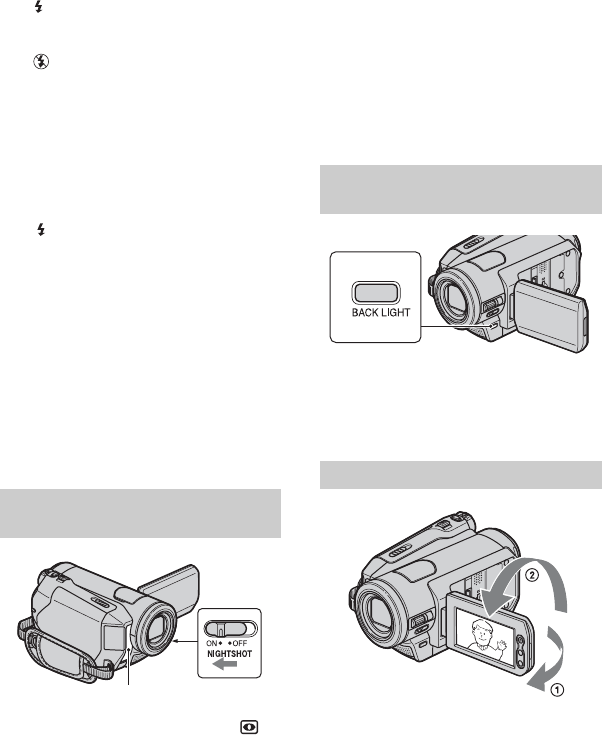
28
r
(Forced flash): Always uses the flash
regardless of the surrounding brightness.
r
(No flash): Records without flash.
b Notes
• The recommended distance to the subject when
using the built-in flash is 0.3 to 2.5 m (1 to 8
feet).
• Remove any dust from the surface of the flash
lamp before using it. Flash effect may be
impaired if heat discoloration or dust obscures
the lamp.
• The /CHG (charge) lamp flickers when
charging the flash, and remains lit when the
flash charge is ready. (In [STBY] of the
CAMERA-TAPE mode, it takes a while to fully
charge the flash.)
• You cannot use the flash during tape recording.
• If you use the flash in bright places such as
when shooting a backlit subject, the flash may
not be effective.
z Tips
• You can change the brightness of the flash by
setting [FLASH LEVEL], or you can prevent
the redeye by setting [REDEYE REDUC], in
[FLASH SET] (p. 47).
Set the NIGHTSHOT switch to ON (
and [“NIGHTSHOT”] appear).
b Notes
• The NightShot and Super NightShot functions
use infrared light. Therefore, do not cover the
infrared port with your fingers or other objects
and remove the conversion lens (optional).
• Adjust the focus manually ([FOCUS], p. 46)
when it is hard to focus automatically.
• Do not use these functions in bright places. This
may cause a malfunction.
z Tips
• To record an image brighter, use Super
NightShot function (p. 47). To record an image
more faithful to the original colors, use Color
Slow Shutter function (p. 48).
To adjust the exposure for backlit subjects,
press BACK LIGHT to display .. To
cancel the back light function, press BACK
LIGHT again.
Open the LCD panel 90 degrees to the
camcorder (1), then rotate it 180 degrees
to the lens side (2).
z Tips
• A mirror-image of the subject appears on the
LCD screen, but the picture will be normal
when recorded.
Recording in dark places
(NightShot)
Infrared port
Adjusting the exposure for
backlit subjects
Recording in mirror mode
Recording (Continued)


















